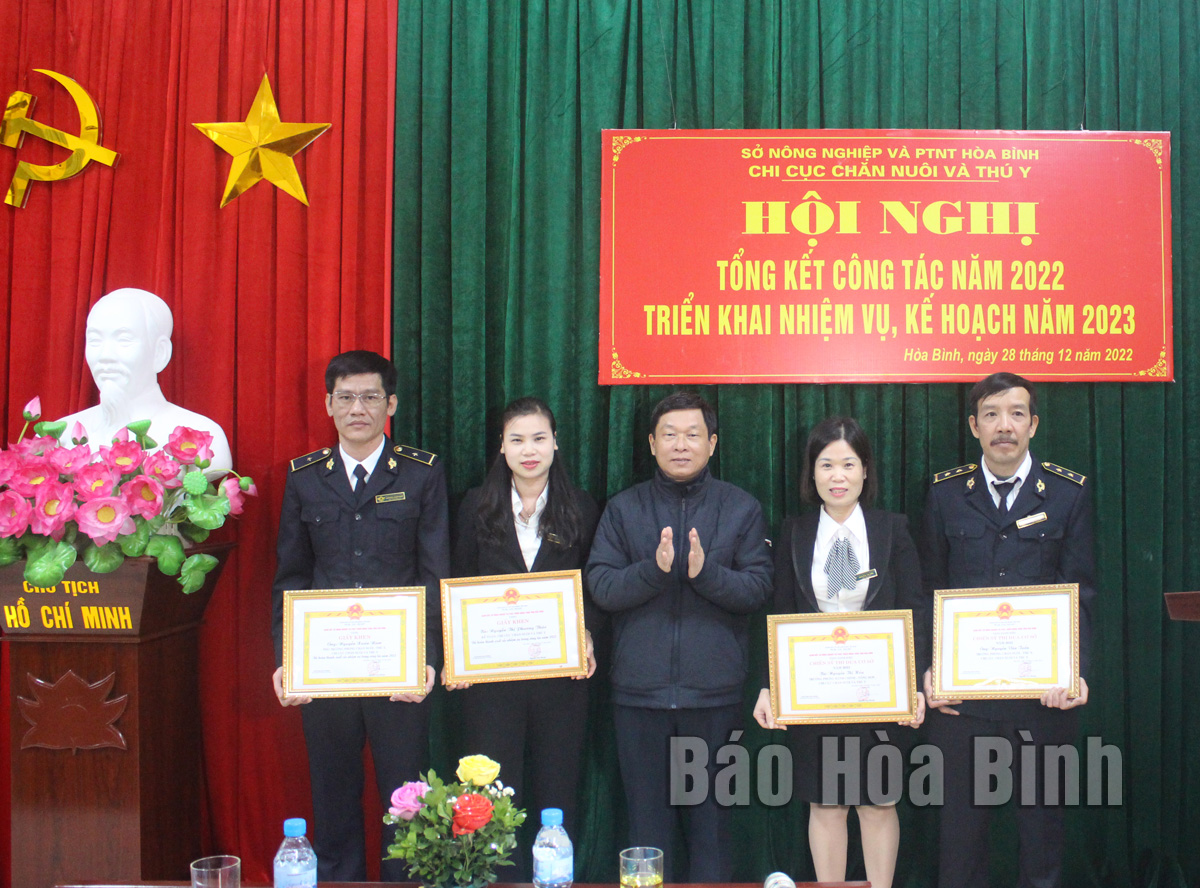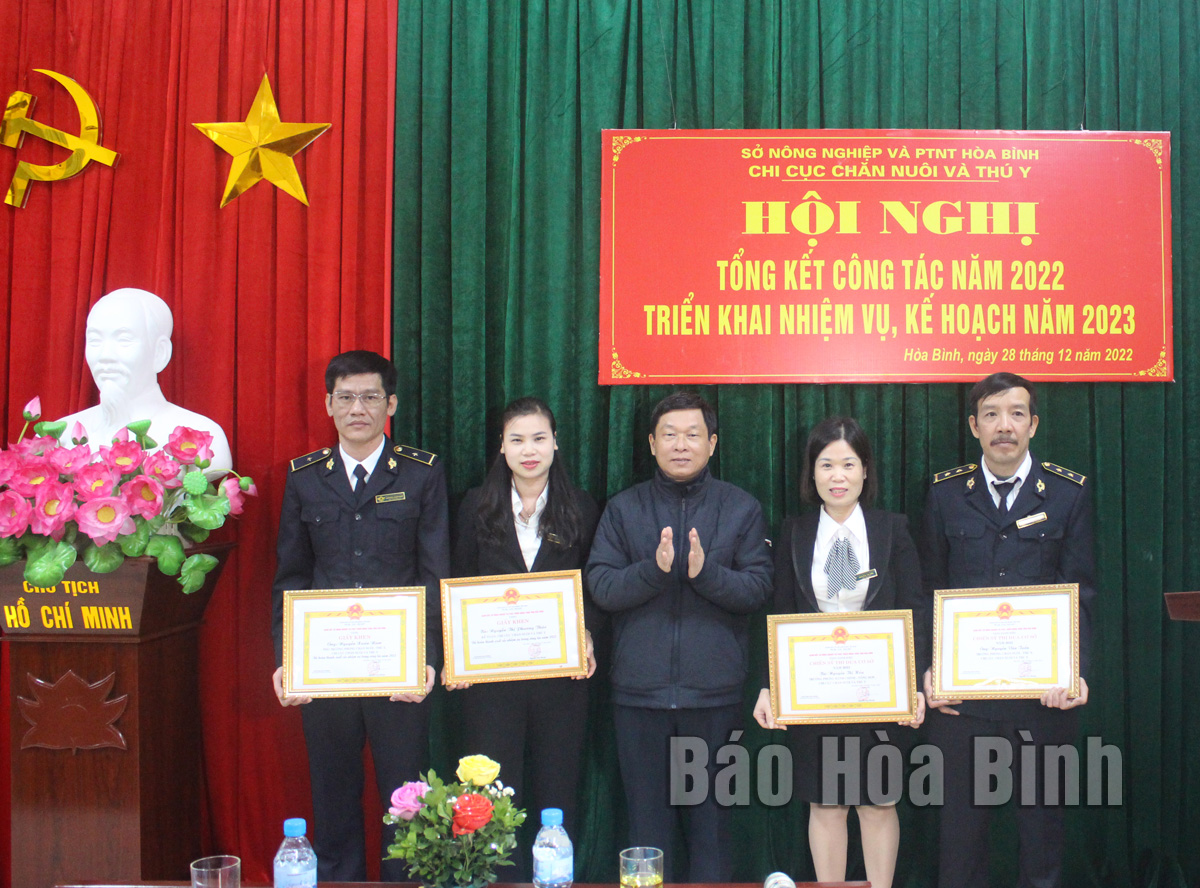
(HBO) - In the morning of December 28, the Sub-Department of Livestock Production and Veterinary organized a review of the work in 2022, implementing the tasks and plans for 2023.
The leaders from the Department of Agriculture and Rural Development were commending the collectives and the individuals for excellently completing the tasks in 2022.
In 2022, livestock production in the province has been stably maintained. However, due to the slow decrease in the input prices and the output prices were fluctuating continuously in the direction of the rapid decline, therefore, it directly affected the small-scale farmers. The concentrated farm animal husbandry continued to stabilize and develop in the direction of linking production and consumption of products. The investment attraction, the chains of the livestock linkage continued to develop in both size and quantity and quality. The production value of the animal husbandry at the constant prices for the whole year was estimated at 3.87 trillion VND, increasing 6.24% compared to that of the same period. During the year, the animal epidemics was relatively stable, however, some dangerous diseases such as pasteurellosis in cattle, African swine fever sporadically appeared.
In 2023, the animal husbandry is trying so that the production value at the constant prices will reach 3.9 trillion VND. The total livestock herd is 9,695 million heads (the buffalo herd is 115 thousand, the cow herd is 90 thousand, the pig is 490 thousand, the poultry is 9,000 thousand). It is necessary to timely implement the plans for prevention and control of the disease for the terrestrial and aquatic animals; ensuring that the rate of at least 80% of the total herd and 100% are subject to vaccination; regularly organizing the additional injections for newly imported livestock to create the active immunity. The sterilization and disinfection campaigns is implemented, trying to ensure 4 times a year.
On this occasion, the Department of Agriculture and Rural Development, the Sub-Department of Livestock Production and Veterinary were commending the individuals and the collectives for successfully completing the tasks in 2022.
According to data from the Hoa Binh Provincial Party Committee, the industrial production index for the first six months of 2025 is estimated to have increased by 20% compared to the same period last year. This marks the highest year-on-year growth rate for this period since 2020.
In the first six months of 2025, Hoa Binh province’s export turnover was estimated at 1.145 billion USD, marking an 18.11% increase compared to the same period in 2024. Import turnover was estimated at $ 804 million, a 17.15% increase, which helped the province maintain a positive trade balance.
The lives of the ethnic minority farmers in Tan Lac district have gradually improved thanks to the new directions in agricultural production. This is a testament to the collective strength fostered through the professional associations and groups implemented by various levels of the district’s Farmers’ Union.
With the motto the "product quality comes first,” after nearly one year of establishment and operation, Muong village’s Clean Food Agricultural and Commercial Cooperative, located in Cau Hamlet, Hung Son Commune (Kim Boi district), has launched reputable, high-quality agricultural products to the market that are well-received by consumers. The products such as Muong village’s pork sausage, salt-cured chicken, and salt-cured pork hocks have gradually carved out a place in the market and they are on the path to obtaining the OCOP certification.
In the past, the phrase "bumper harvest, rock-bottom prices" was a familiar refrain for Vietnamese farmers engaged in fragmented, small-scale agriculture. But today, a new spirit is emerging across rural areas of Hoa Binh province - one of collaboration, organisation, and collective economic models that provide a stable foundation for production.
Maintaining growing area codes and packing facility codes in accordance with regulations is a mandatory requirement for agricultural products to be eligible for export. Recently, the Department of Agriculture and Environment of Hoa Binh province has intensified technical supervision of designated farming areas and packing facilities to safeguard the "green passport" that enables its products to access international markets.



